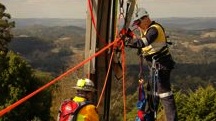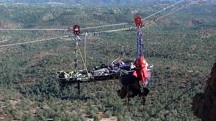Most rope rescues (>95%) are top down in nature due to the fact that the rescue team is able to gain access to a position above the victim's location to perform the rescue. The STRW addresses these important distinctions early on with both structure-based and ground-based rescue techniques then moves on into in-depth orientation on lattice steel and monopole radio and power transmission tower construction, climbing techniques and hazards, all for the emergency responder.
This is the first and only seminar carefully delineating the many hazards associated with energized power transmission lines for fire fighters. 99% of all above ground towers are power lines. This seminar will take away the mystique and uncertainty of sending emergency responders up these dangerous towers during incidents.
The STRW also features recently completed DVD support form the Highline Production training materials "TOWER RESCUE for EMERGENCY RESPONDERS". Before the rescue section begins, students learn several ways of safely climbing a tower using time-tested climbing methods, rest positions, and tips for route strategy. Many of these techniques are used today by seasoned workmen who work on towers as part of their daily employment. All climbing is taught with first-up fall protection and established self belay lines for all subsequent climbers on the tower. This rigorous workshop teaches rescue of uninjured, ill, slightly injured or injured workers or unauthorized climbers on lattice steel and monopole structures up to 40m.
STRW key points:
• Awareness orientation on different types of towers
• Methods of climbing with fall protection:
Double lanyard
Advance-placed
Lead climbing
• Emergencies associated with structures
• Structure size-up
• Tower types and awareness
• Electrical power transmission towers and hazards
• Rescue options (team or solo)
• Extreme tower rescue (>150 ft.)
• Climbing exposure assessment
• Minimum tower rescue essentials
• Medical considerations & patient assessment
• Patient packaging while hanging
• Patient extrication using litter scoop and LSP Halfback®
• Conductor or aerial cable rescue
• Ground-based versus structure-based tower rescues
• Electrical grounding hazards
• Radio frequency hazards
Much more …



